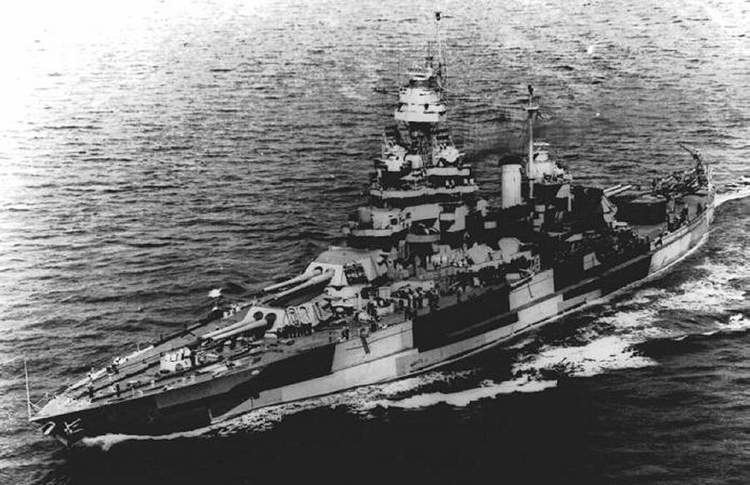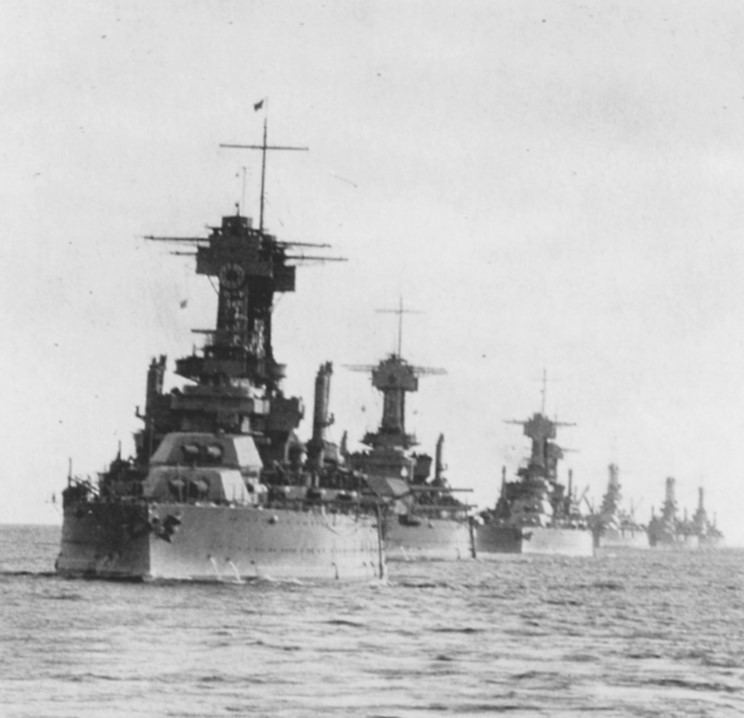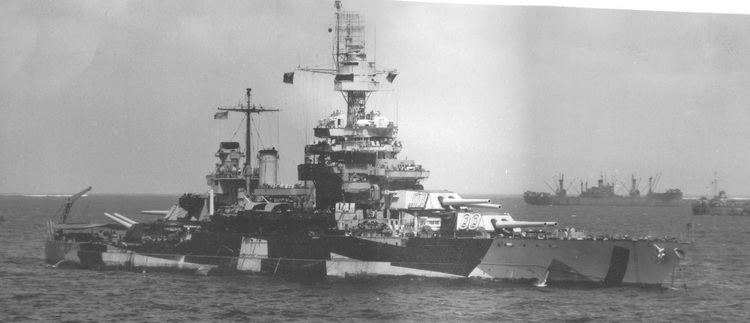Name Colorado Ordered 29 August 1916 Sponsored by Mrs. Max Melville Construction started 29 May 1919 Length 190 m | Namesake State of Colorado Laid down 29 May 1919 Commissioned 30 August 1923 Launched 22 March 1921 Beam 30 m | |
 | ||
The battleship uss colorado bb 45 entering pearl harbor hawaii united states hd stock footage
The USS Colorado (BB-45) was a battleship of the United States Navy that was in service from 1923 to 1947. She was the lead ship of the Colorado class of battleships and the third naval ship named for the 38th state. Her keel was laid down on 29 May 1919 by the New York Shipbuilding Corporation. She was launched on 22 March 1921 and commissioned on 30 August 1923. She was armed with eight 16-inch (406 mm) guns and fourteen 5-inch (127 mm) deck guns; two 5-inch guns were removed in an overhaul.
Contents
- The battleship uss colorado bb 45 entering pearl harbor hawaii united states hd stock footage
- Battleship uss colorado bb 45 in the pacific during world war ii gun crews tra hd stock footage
- Description
- Construction and commission
- Inter war period
- World War II
- Post war
- Artifacts on display
- References

Colorado took her maiden voyage in 1923 to Europe. She later operated with the Battle Fleet and sailed through the Pacific during the interwar years. She also underwent a further refit, during which her four 3-inch (76 mm) anti-aircraft guns were replaced with an equal number of 5 in (127 mm)/25 cal guns.

During the early part of World War II, Colorado undertook a defensive patrol near the Golden Gate Bridge in May 1942 to stop a possible Japanese invasion. She then sailed to Fiji to stop any further Japanese advance into the Pacific. Next, she supported the landings on Tarawa, the Marshall Islands, Saipan, Guam, and Tinian. On 24 July 1944, during the shelling of Tinian, Colorado received 22 shell hits from shore batteries, but continued to support the invading troops until 3 August. She later arrived in Leyte Gulf on 20 November 1944 to support American troops fighting ashore. On 27 November, she was hit by two Kamikazes which caused moderate damage.

After that, Colorado sailed to Luzon on 1 January 1945, where she participated in the preinvasion bombardments in Lingayen Gulf. She returned to Okinawa on 6 August and sailed from there to Japan for the occupation of the country, arriving in Tokyo on 27 August. Departing Tokyo Bay on 20 September, she arrived at San Francisco on 15 October. She was placed out of commission in reserve in Pearl Harbor on 7 January 1947, and sold for scrapping on 23 July 1959. She won seven battle stars during her service. Many of Colorado's anti-aircraft guns are in museums across the state of Colorado (her bell and teak decking are also in museums) or mounted on the museum ship Olympia.

Battleship uss colorado bb 45 in the pacific during world war ii gun crews tra hd stock footage
Description

Colorado was 624 feet 3 inches (190.27 m) long overall, had a beam of 97.5 ft (29.7 m) and a draft of 38 ft (12 m). She displaced 32,100 long tons (32,600 t) as designed and up to 33,060 long tons (33,590 t) at full load. The ship was powered by a four-shaft turbo-electric drive, rated at 28,900 shaft horsepower (21,600 kW) and eight Babcock & Wilcox boilers, generating a top speed of 21 knots (39 km/h; 24 mph). She had a range of 8,000 nautical miles (15,000 km; 9,200 mi) at a speed of 10 knots (19 km/h; 12 mph). She had a crew of 1,080 officers and enlisted men.
She was armed with a main battery of eight 16-inch (406 mm)/45 caliber Mark 1 guns in four twin gun turrets on the centerline, two forward and aft. The secondary battery consisted of fourteen 5-inch (127 mm)/51 caliber guns, two of which were removed in an overhaul. The anti-aircraft defense consisted of four 3-inch (76 mm)/23 caliber guns, which were soon replaced, first by 5-inch (127 mm)/25 caliber guns, and then by 5-inch (127 mm)/38 caliber guns. As was standard for capital ships of the period, Colorado carried two 21 in (533 mm) torpedo tubes in deck-mounted launchers.
Colorado's main armored belt was 13.5 in (343 mm) thick over the magazines and the machinery spaces and 8 in (203 mm) elsewhere. The main battery gun turrets had 18-inch (460 mm) thick faces, and the supporting barbettes had 13 in (330 mm) of armor plating on their exposed sides. Armor that was 3.5 in (89 mm) thick protected the decks. The conning tower had 11 in (280 mm) thick sides.
Construction and commission
Her keel was laid down on 29 May 1919 by the New York Shipbuilding Corporation of Camden, New Jersey. She was launched on 22 March 1921 sponsored by Mrs. Max Melville, Denverite, daughter of United States Senator from Colorado Samuel D. Nicholson; and commissioned on 30 August 1923. The ship's first commanding officer was Captain Reginald R. Belknap.
Inter-war period
Colorado departed New York Harbor on 29 December 1923 to start a maiden voyage to Europe. The voyage took her to Britain, France, Italy and the peninsula of Gibraltar, with port calls to Portsmouth, Cherbourg, Villefranche, Naples, and the British base at Gibraltar. She returned to New York Harbor on 15 February 1924 and upon her return completed some final tests and undertook some repairs before sailing to the U.S. West Coast for force assignment. She steamed from New York Harbor on 11 July and arrived at San Francisco on 15 September.
Over the next twelve years, Colorado was assigned to the Pacific Battle Fleet, during which time she participated in numerous exercises and ceremonies along with the rest of the fleet. She returned to the East Coast on several occasions to help with fleet problems in the Caribbean and also took a cruise to Samoa, Australia, and New Zealand from 8 June to 26 September 1925 to show the U.S. flag in the southwestern Pacific. She ran aground on the Diamond Shoals off Cape Hatteras, North Carolina, on 1 May 1927, but was refloated on 2 May 1927. She was overhauled in 1928–1929, during which her four 3-inch (76 mm) anti-aircraft guns were replaced by eight 5-inch (130 mm)/25 caliber guns. In 1932, went to Long Beach to help with the damage caused by the earthquake there.
In the summer of 1937 Colorado was the training ship for NROTC students from the University of Washington and University of California, Berkeley. She embarked the University of Washington students in Puget Sound on 15 June, and the University of California students four days later in San Francisco Bay. The ship arrived in Hilo, Hawaii, on 26 June and sailed two days later for Lahaina Roads, where the students practiced firing the 5"/51 caliber guns in whose casemates they were berthed in hammocks. Liberty in Honolulu began on 1 July, but was interrupted the following day so Colorado could join the search for Amelia Earhart. She rendezvoused with the Coast Guard cutter Itasca on 7 July; and launched seaplanes to search the Phoenix Islands. After holding a line-crossing ceremony on 9 July, she returned the NROTC students to their schools on the west coast.
World War II
From 27 January 1941, Colorado was based in Pearl Harbor undergoing intensive training exercises and taking part in several war games until 25 June, when she departed Hawaii for the West Coast. Undergoing overhaul at the Puget Sound Navy Yard, she was not present for the attack on Pearl Harbor on 7 December. During the refit, two of the 12 original 5 in/51 caliber guns were removed, and were replaced by an equal number of 5 in/38 caliber guns. On 31 May, she and Maryland patrolled near Golden Gate Bridge to protect San Francisco from any Japanese attack.
After refit work was completed on 31 March 1942, Colorado carried out extensive training maneuvers along the West Coast, before returning to Pearl Harbor to complete her final preparations for action. She operated in the vicinity of the Fiji Islands and New Hebrides from 8 November 1942 to 17 September 1943 to prevent any further Japanese expansion in the Pacific. She sailed from Pearl Harbor on 21 October 1943 to provide pre-invasion shelling and fire support for the invasion of Tarawa, returning to port on 7 December 1943. After another overhaul on the West Coast, Colorado returned to Lahaina Roads, in the Hawaiian Islands, on 21 January 1944 and sortied the next day for the Marshall Islands. She provided the pre-invasion bombardment and fire support for the invasions of Kwajalein and Eniwetok until 23 February, when she headed for the Puget Sound Navy Yard for another overhaul.
She joined other units going for the Mariana Islands at the harbor at San Francisco. She departed on 5 May passing Pearl Harbor and Kwajalein to the pre-invasion shelling at Saipan, Guam, and Tinian after 14 June. During the shelling of Tinian on 24 July she was damaged, 43 men were killed, and 198 wounded by 22 shell hits from Japanese shore batteries; she continued shelling the island and providing fire support for the invasion troops. After undergoing extensive repairs along the West Coast, she arrived in Leyte Gulf to begin the invasion of Leyte. A week after her arrival she was struck by two kamikaze suicide bombers, which killed 19 crewmembers, injured 72, and moderately damaged the ship. Despite the damage, she bombarded Mindoro on schedule from 12 to 17 January 1945. She then proceeded to Manus Island for urgent repairs.
She returned to Luzon on New Year's Day 1945 to participate in the pre-invasion shelling of the Lingayen Gulf. She was hit by accidental gunfire eight days later. The gunfire hit her superstructure, and caused 69 casualties (18 killed, 51 wounded). After a few repairs at the island of Ulithi, she joined in the pre-invasion shelling group for the invasion of Okinawa at Kerama Retto. She stayed at Okinawa until 22 May, providing anti-aircraft cover and fire support for the invasion troops. On 6 August, she returned to the occupied Okinawa to sail to Japan for its occupation. On 27 August, she covered the airborne occupation of Atsugi Airfield.
Colorado was awarded seven battle stars for her World War II service.
Post war
Colorado departed Tokyo Bay on 20 September 1945 for San Francisco. She arrived there on 15 October, and then sailed for Seattle for Navy Day (27 October). She was part of the Operation Magic Carpet force, making three runs to Pearl Harbor to transport 6357 soldiers home, before returning to Bremerton Navy Yard for her deactivation. She was placed out of reserve commission on 7 January 1947 and was sold for scrap on 23 July 1959.
Artifacts on display
The ship's bell is currently on display in the University Memorial Center (UMC) at the University of Colorado. A 5 in (130 mm)/51 cal deck gun from Colorado was donated to the Puget Sound Maritime Historical Society in 1959, and is displayed at the Museum of History and Industry in Seattle. It was one of eight such guns on Colorado.
Six of Colorado's 5/51 cal guns were put aboard the protected cruiser USS Olympia, after she became a museum in Philadelphia in 1957. Boards from her deck were re-purposed to form a wall in the main lounge of Haggett Hall at the University of Washington. A plaque commemorates the source.
On 7 February 2014, Boeing donated the teak decking of Colorado to the USO Northwest SeaTac Center to serve as the new center’s entry flooring. Her helm is in the collection of the Colorado Springs Museum. It was donated to the museum in 1961 by Rear Admiral G. R. Luker and other naval officers. Admiral Luker served on Colorado. The donation also included a bronze plaque and other historical materials.
